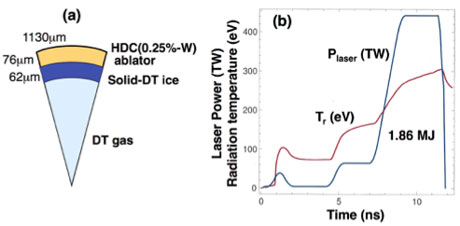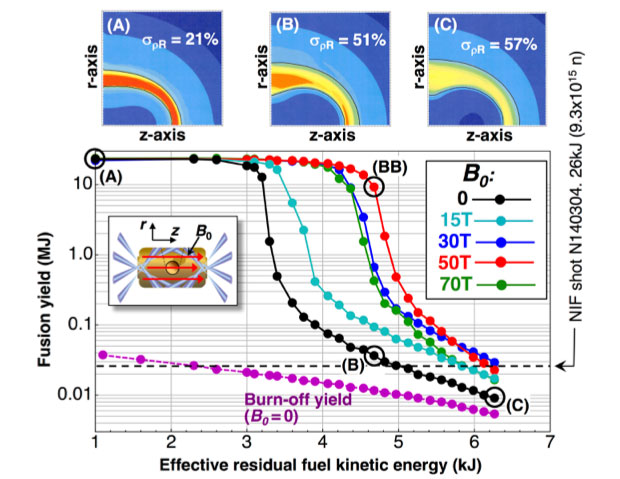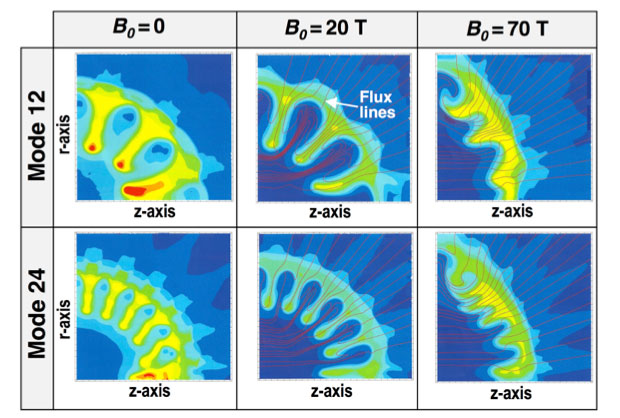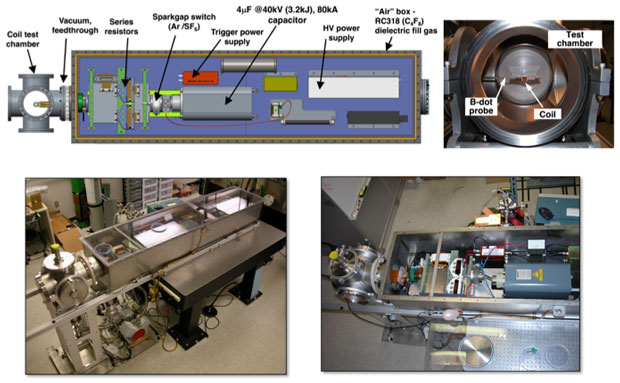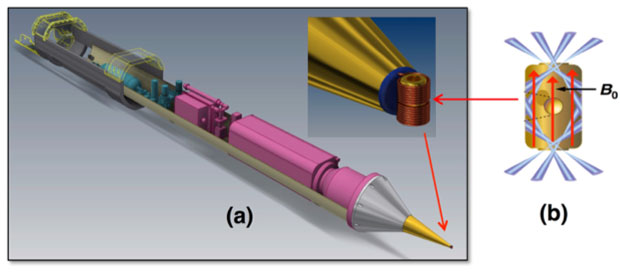L. John Perkins (14-ERD-028)
Abstract
In this project, we examined the science and associated technology basis for imposed magnetic fields in Inertial Confinement Fusion on the National Ignition Facility (NIF). Initial seed fields of tens of teslas (T) that compress to greater than 104 T (100 MGauss) under implosion may relax the conditions required for ignition and propagating burn in Inertial Confinement Fusion. This may allow the attainment of ignition, or at least significant fusion energy yields, in presently performing NIF targets that today are sub-marginal for thermonuclear burn through adverse hydrodynamic conditions at stagnation. Results of detailed two-dimensional radiation-hydrodynamic-burn simulations applied to NIF capsule implosions with low-mode shape perturbations and residual kinetic energy loss indicate that such compressed fields may increase the probability for ignition through the range reduction of fusion alpha particles, the suppression of electron heat conduction, and the potential stabilization of higher-mode Rayleigh–Taylor instabilities. The tens of teslas magnetic field required for NIF ignition hohlraums can be provided via a single-layer coil wound on the outside of the hohlraum driven by conventional pulsed power technology. We also performed modeling and design of a candidate power supply and coil that could be integrated on the NIF, together with the construction and testing of a 4 μF, 40 kV system on a stand-alone test stand. We obtained maximum coil fields of up to 58 T over ~2-ms pulse lengths. Given the full plasma structure in a NIF capsule at stagnation may be governed by three-dimensional resistive magnetohydrodynamics, the formation of closed magnetic field lines might further augment ignition prospects. NIF experiments are now essential to assess the potential of applied magnetic fields to Inertial Confinement Fusion ignition and burn.
Background and Research Objectives
In Inertial Confinement Fusion, around a milligram of deuterium–tritium fuel is rapidly compressed to high temperatures sufficient for thermonuclear fusion to commence. The complete burn of a 50:50 mix of deuterium–tritium through the fusion reaction 2H + 3H → n + 4He + 17.6 MeV releases a specific energy of 3.4 x 1011J/g. The NIF is seeking to demonstrate laser-driven Inertial Confinement Fusion ignition and thermonuclear burn in the laboratory for the first time by indirect-drive.1 Here, laser energy is first converted to x-rays in a hohlraum enclosing the spherical shell of the fuel capsule. The radiation absorbed in an ablator surrounding the fuel implodes the capsule at high velocity until spherical convergence and back pressure decelerates this hydrodynamic “piston,” compressing its fuel, and converting its kinetic energy into thermal work (PdV) on a central gas “hotspot.” Under the right conditions, this could initiate fusion ignition, i.e., a thermonuclear burn wave propagating out from the hotspot into the compressed fuel via deposition of 3.5 MeV alpha particles from the deuterium–tritium reaction, resulting in fusion energy yields of ≿1 MJ.
Achieving Inertial Confinement Fusion ignition with high fusion yield is one of the grand challenges of science. The ignition campaign on the NIF has made significant progress returning data of unprecedented quality and diagnostic precision in over 80 cryogenic deuterium–tritium target implosions to date.2,3,4,5 However, the compressed fuel densities and hotspot pressures remain around one-half that required for ignition so that resulting fusion yields are around a factor of ten too low to initiate bootstrap alpha heating. Continuing progress is evident by the highest fusion yield shots now showing clear evidence of initial stages of self-heating by alpha particle deposition.6 It is in this transitional regime that imposed magnetic fields may play a major role in that they may permit the recovery of ignition and high fusion yield in otherwise the same targets with the same perturbed stagnation conditions.
In compressing an Inertial Confinement Fusion capsule in an imposed magnetic field, the highly conductive plasma is characterized by a large magnetic Reynolds number–ratio of the magnetic advection to magnetic diffusion. Given that NIF capsule implosion times are less than one-hundredth of characteristic magnetic resistive diffusion times, the magnetic flux would be effectively frozen in and the field would compress to high values. Magnetizing a plasma with a compressed field will reduce electron heat conduction loss perpendicular to the field. Electron confinement and suppression of perpendicular electron heat conduction requires compressed fields of ≳103 T (10 MGauss). Stronger compressed fields of ≳104 T (100 MGauss) can localize the deposition range of 3.5 MeV fusion alpha particles within the hotspot to around that of their Larmor gyro orbits. Reducing electron heat conduction and enhancing alpha energy deposition density results in an associated reduction in the minimum hotspot conditions required for ignition and propagating burn. A third feature is that the frozen-in field structure can be stabilizing to high-mode Rayleigh–Taylor instabilities.
The seed field may also ameliorate laser-plasma instability conditions within the hohlraum volume such as stimulated Raman and Brillouin scattering that cause laser backscatter efficiency loss and modify hot electron preheat of the capsule.
Accordingly, it was the goal of this research to examine the science and associated technology basis for imposed magnetic fields in Inertial Confinement Fusion targets on the NIF. Such fields may allow the attainment of ignition, or at least significant fusion energy yields, in presently-performing NIF targets that today are sub-marginal for thermonuclear burn.
Scientific Approach and Accomplishments
Detailed simulations for this work were performed with the LASNEX radiation-hydrodynamics code7 for a standard NIF ignition capsule with a diamond ablator.5 The capsule design and laser pulse shape are shown in Figure 1.
We made this capsule sub-marginal for ignition by applying perturbations to approximate stagnation conditions deduced from comparison of NIF experiments with simulations8,9,10 and then examined conditions under which an imposed magnetic field might recover ignition. Specifically, we sought to encompass the experimental observations that: (1) the cold fuel “piston” is not round at stagnation, and that results in less ideal spherical compression and a larger surface area for hotspot heat conduction loss; (2) the areal density of the piston can have variations of up to a factor of two as a function of equatorial angle, which results in less efficient hotspot tamping with less momentum/energy transfer to the hotspot thermal content; (3) the residual kinetic energy remaining in the cold fuel structure at stagnation can be in excess of 50% of the peak inflight value, resulting in inefficient conversion of shell kinetic energy to hotspot thermal energy.
In Figure 2, the solid black line shows resulting fusion yields from LASNEX simulations under the above observed conditions of imposed drive shape perturbation and increasing residual kinetic energy and no imposed magnetic field. The resulting density contours at stagnation in the r-z plane are also indicated at three representative points A, B, and C. At low residual kinetic energy and with only modest shape distortions, the capsule ignites with full yields of ~20MJ. As the residual kinetic energy and shape distortions increase, the fusion yield falls over three orders of magnitude to low values where energy deposition from fusion alpha particles is negligible.
Figure 2 also indicates the fusion energy yield (26.2 kJ) from NIF shot N140304—the highest performing Inertial Confinement Fusion experiment to date.6 Other similarly performing shots were N140120 (26.1 kJ) and N140520 (25.3 kJ). It is important to note that such shots are on the foot of the alpha-heated ignition cliff and is the regime where magnetic fields may offer the most benefit to enhancing ignition performance.
The colored curves in Figure 2. show fusion yield enhancement predicted by LASNEX for initial imposed axial fields of 20 through 70 T for the same inflight conditions—i.e., same shape and residual kinetic energy perturbations—as for the black (no-field) curve. These simulations accommodated a full set of magnetohydrodynamic phenomena including JxB forces (magnetic pressure), Braginskii cross-field transport model for degenerate matter, magnetic diffusion, the Nernst term, and orbit-following-deposition of fusion burn product charged particles along the field lines. The result of the imposed field is to translate the ignition cliff to the right so that implosions can achieve ignition with enhanced fusion yields at inflight conditions that would otherwise result in only low yields. An optimum in the enhanced yield performance is seen for imposed fields around 50 T, which resulted in a compressed field at full capsule convergence of 5.3 x 104 T (530 MGauss)—a compression ratio of >1,000. Lower fields result in larger alpha particle gyro orbits with less localization within the hotspot, while higher fields result in increasing shell shape distortion due to compressed field back pressure and increasingly asymmetric heat conduction.
The most marked benefit of the applied field is for capsule implosions that, without field, are on the foot of the ignition cliff and would ordinarily obtain only around twice the fusion yield relative to burn-off conditions. It is important to note that this is where our best performing NIF capsules lie today experimentally6 and thus they may be appropriate candidates for fusion yield enhancement and perhaps ignition under imposed fields.
In addition to the dominant effect of low mode radiation-flux-driven asymmetries, yield degradations in present National Ignition Facility target experiments have been attributed to the capsule support tent and fill-tube.9,10 These are higher-mode Rayleigh–Taylor instabilities—e.g., the fill-tube perturbation can present as a thin jet of higher-z material penetrating the hotspot. However, in a magnetized implosion, the field lines would be frozen into the shell. Given the pressure gradient is opposite to the field gradient, then for the deceleration Rayleigh–Taylor modes to grow during late time capsule deceleration, they would have to cause sharp curvature of their entrained flux. This would increase field line bending energy and thus should be stabilizing to such interchange-like modes. To examine this potential, in Figure 3 we show the effect of applying two single-mode perturbations of mode number 12 and 24 and of large initial 5 µm amplitude to the inner deuterium–tritium-ice surface of the capsule in Figure 1 for imposed fields of B0 = 0, 20 and 70 T. The frozen-in field lines are evident for the magnetized cases as is the significant damping of the non-linear Rayleigh–Taylor growth. These are relatively low mode numbers so we might expect increased stabilization for higher modes due to increased bending energy required.
Our hohlraum magnetohydrodynamics physics modeling looked at the effects of an imposed field on hohlraum and capsule dynamics. The underdense hohlraum fill is strongly magnetized, and electron heat conduction perpendicular to the field is strongly reduced. This gives a higher electron temperature. We find this reduces inverse-bremsstrahlung absorption of the inner laser beams, which propagate better to the equatorial wall. The resulting capsule implosions are more prolate (“sausage”) in shape than without the field. The higher fill temperature may also reduce the level of stimulated Raman scattering. We also examined the dynamics of energetic or “hot” electrons, which tend to follow magnetic field lines. These can be guided toward or away from the capsule, depending on when and where they are generated.
The tens of teslas magnetic field required for NIF ignition hohlraums can be provided via the relatively simple expediency of a single-layer coil wound on the outside of the hohlraum driven by conventional pulsed power technology. The modeling and design of a candidate NIF power supply and coil system was performed in this work together with the construction and testing of a 4 μF, 40k V system on a stand-alone test stand (no laser or Inertial Confinement Fusion targets) as shown in Figure 4. Several coil configurations were tested including an 18-turn, center-fed coil of 24-AWG wire on a 10 μm-wall-thickness uranium cylinder designed as a proxy for a NIF uranium hohlraum and of the same dimensions. Eddy currents induced in the uranium wall had no appreciable effect on the field rise time or wall motion during the pulse. We obtained maximum coil fields of up to 58 T over ~2 μs pulse length.
The final pulsed power supply for the NIF could be located in a diagnostic insertion manipulator, likely TANDM 90-348. A room-temperature version was designed in this project and is illustrated in Figure 5a while application to the NIF cryo-ignition targets will require coupling of the room temperature transmission line from the power supply to a cryogenic hohlraum coil in the cryogenic cryo-TARPOS target positioner. The deuterium–tritium fuel capsule is mounted in the center of the cylindrical hohlraum (Figure 5b) and the coil is designed to produce an applied axial seed magnetic field of ~50 T in the hohlraum volume for a few microseconds, during which time the capsule is imploded on the field (~10–15 ns).
Conclusion
In summary, our radiation-hydrodynamic simulations predict that imposed seed magnetic fields of tens of teslas that compress to greater than 104 T (100 MGauss) under implosion might relax the conditions required for ignition and propagating burn in Inertial Confinement Fusion capsules. This accrues through range reduction of fusion alpha particles, suppression of electron heat conduction, and potential stabilization of higher-mode hydrodynamic instabilities. This may allow the attainment of ignition, or at least significant fusion energy yields, in presently performing Inertial Confinement Fusion targets on the NIF that today are not sufficient for thermonuclear burn through adverse hydrodynamic conditions at stagnation.
A caveat is that our physics results are contingent on a two-dimensional interpretation of the physics whereas stagnation dynamics are likely three-dimensional phenomena. Thus, an interesting question is whether the three-dimensional hydrodynamics of the residual kinetic energy plasma structure around stagnation may form orthogonal toroidal field components. That is, would the tangling and resulting intense flux gradients promote reconnection of otherwise frozen-in axial flux to form closed field lines in the hotpot? If so, this might further augment ignition probability because electron and alpha charged particle transport is then suppressed in all directions. This rich physics involves complex 3D resistive magnetohydrodynamics and is likely beyond the scope of any present radiation-hydrodynamics code to accommodate with confidence.
Accordingly, proof-of-principle experiment are now essential to examine the potential of imposed magnetic fields to Inertial Confinement Fusion ignition and burn on the NIF.
References
- Lindl, J. D., et al., “The physics basis for ignition using indirect-drive targets on the National Ignition Facility.” Phys. Plasma. 11, 339 (2004). http://dx.doi.org/10.1063/1.1578638
- Edwards, M. J., et al., “Progress towards ignition on the National Ignition Facility.” Phys. Plasma. 20, 070501 (2013). http://dx.doi.org/10.1063/1.4816115
- Hurricane, O. A., et al., “The high-foot implosion campaign on the National Ignition Facility.” Phys. Plasma. 21, 056314 (2014). doi: http://dx.doi.org/10.1063/1.4874330
- Kline, J. L., et al., “First beryllium capsule implosions on the National Ignition Facility.” Phys. Plasma. 23, 056310 (2016). http://dx.doi.org/10.1063/1.4948277
- Meezan, N.B., et al., “Cryogenic tritium–hydrogen–deuterium and deuterium–tritium layer implosions with high density carbon ablators in near-vacuum hohlraums.” Phys. Plasma. 22, 062703 (2015). http://dx.doi.org/10.1063/1.4921947
- Doppner, T., et al., “Demonstration of high performance in layered deuterium–tritium capsule implosions in uranium hohlraums at the National Ignition Facility.” Phys. Rev. Lett. 115, 055001 (2015).
- Harte, J. A., LASNEX – A 2-D Physics Code for Modeling ICF. (1996). UCRL-LR-105821-96-4.
- Clark, D. S., et al., “Detailed implosion modeling of deuterium–tritium layered experiments on the National Ignition Facility.” Phys. Plasma. 20, 056318 (2013). http://dx.doi.org/10.1063/1.4802194
- Clark, D. S., et al., “Three-dimensional simulations of low foot and high foot implosion experiments on the National Ignition Facility.” Phys. Plasma. 23, 056302 (2016). http://dx.doi.org/10.1063/1.4943527
- Clark, D. S., et al., “Capsule Modeling of High foot implosion experiments on the National Ignition Facility.” Plasma Phys. Contr. Fusion (in print).
Publications and Presentations
- Perkins, L. J., et al., The application of imposed magnetic fields to ignition and thermonuclear burn on the National Ignition Facility. (2015). LLNL-PRES-663377.
- Perkins, L. J., et al., The application of imposed magnetic fields to ignition and thermonuclear burn on the National Ignition Facility. (2015). LLNL-PRES-678000.
- Rhodes, M. A., et al., MagNIFico: A system for high-field magnetized target experiments at the National Ignition Facility. (2015). LLNL-PRES-677026.
- Rhodes, M. A., et al., MagNIFico: A system for high-field magnetized inertial fusion at the National Ignition Facility. (2015). LLNL-PRES-671216.
- Robey, H.F., et al., “Performance of indirectly driven capsule implosions on NIF using adiabat-shaping.” Phys. Conf. Ser. 717 (2016). LLNL-PROC-680487. http://dx.doi.org/10.1088/1742-6596/717/1/012045


